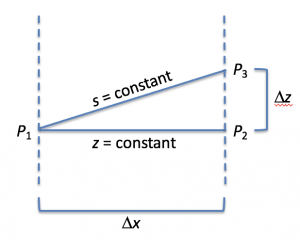66 Dynamic height and horizontal pressure gradients
Let’s start by thinking about the horizontal pressure gradient, but where the numerator uses pressure differences taken along an arbitrary surface (s) that can vary in height. The values along the surface will change by an amount equal to changes along constant z surfaces (the regular Cartesian horizontal gradient), plus an amount that has to do with how the z-value of that surface changes given an existing vertical component of pressure gradient.

![]()
This is formally related to a chain rule expansion of a partial derivative taken where s is a coordinate. In the expression below, the subscript on the vertical line means “keeping that variable constant”.
![]()
Now, consider that the surface in question is a pressure surface, recognizing that constant P surfaces are not always aligned with constant z surfaces in an ocean that is not at rest. The term on the left will be zero since the change in pressure along a constant pressure surface is by definition zero. Thus, the two terms on the right must sum to zero, requiring:
![]()
Now consider the difference in horizontal pressure gradient at two different points in the water column where the pressures are, respectively, P1 and P2 and the heights are, respectively z1 and z2. If we also assume that density changes are a small percentage of the full density such that ![]() at all depths then
at all depths then
![Rendered by QuickLaTeX.com \[ \frac{\partial P}{\partial x}\biggr|_{z_2}-\frac{\partial P}{\partial x}\biggr|_{z_1}=g\rho_0 \left(\frac{\partial z}{\partial x}\biggr|_{P_2}-\frac{\partial z}{\partial x}\biggr|_{P_1} \right) \]](https://uw.pressbooks.pub/app/uploads/quicklatex/quicklatex.com-68f42aeb094583716487d9cffcc53f49_l3.png)
If we then divide through by ![]() , the left side becomes the difference in PGF (pressure gradient force) = –
, the left side becomes the difference in PGF (pressure gradient force) = –![]() at the two levels.
at the two levels.
![Rendered by QuickLaTeX.com \[ PGF_{z_2}-PGF_{z_1}=-g \left(\frac{\partial z}{\partial x}\biggr|_{P_2}-\frac{\partial z}{\partial x}\biggr|_{P_1} \right) \]](https://uw.pressbooks.pub/app/uploads/quicklatex/quicklatex.com-62503ceaec18f19986082adc4ee5026f_l3.png)
The right side is the horizontal gradient in the geopotential difference (gz2-gz1) along constant pressure surfaces, which are related to dynamic height via its definition
![]()
Thus
![]()
Media Attributions
- PGrad.SurfaceS © Susan Hautala is licensed under a CC BY-NC-SA (Attribution NonCommercial ShareAlike) license

